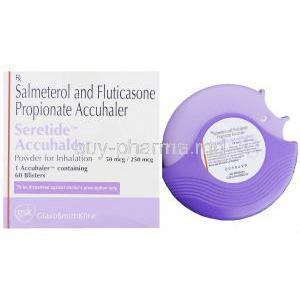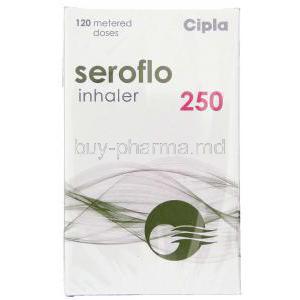Introduction
Composition
How it Works
Uses
Treatment of Asthma
Seretide is a combination inhaler that contains two active ingredients: fluticasone and salmeterol. Fluticasone is a corticosteroid that reduces inflammation in the airways, while salmeterol is a long-acting bronchodilator that relaxes the muscles around the airways and prevents them from narrowing. Together, these ingredients can help people with asthma breathe more easily and prevent asthma attacks 12.
People with asthma find Seretide’s dual action approach very beneficial because it effectively manages both aspects of asthma: inflammation and bronchoconstriction. Seretide can improve the symptoms of asthma, such as wheezing, coughing, chest tightness, and shortness of breath. It can also reduce the need for rescue inhalers, such as salbutamol, that are used to treat sudden asthma attacks 12.
Seretide is prescribed for people whose asthma is not well controlled by using a regular preventer inhaler (a corticosteroid) with a reliever inhaler (a short-acting bronchodilator) as needed. Seretide should be used regularly every day, even when there are no asthma symptoms, to prevent inflammation and bronchoconstriction from occurring. However, Seretide does not cure asthma and it is not suitable for everyone. It may have some side effects and interactions with other medications. Therefore, it should only be used under the guidance of a doctor who can monitor its effects and adjust the dosage accordingly 12.
Chronic Obstructive Pulmonary Disease (COPD)
Seretide is a combination of two active ingredients, fluticasone propionate and salmeterol xinafoate, that work together to treat COPD1. Fluticasone propionate is a corticosteroid that reduces inflammation in the airways, while salmeterol xinafoate is a long-acting beta2-agonist that relaxes the muscles around the airways and prevents bronchospasm12. Seretide helps improve lung function and enhances the quality of life for individuals dealing with this long term ailment by reducing the frequency and severity of COPD exacerbations3 .
1: Seretide: Uses, Side Effects, Interactions 2: Systemic inflammation in chronic obstructive pulmonary disease 3: Systemic inflammation and comorbidity in COPD: a result of … - Thorax : Airway inflammatory changes in the lungs of patients with asthma-COPD overlap (ACO): a bronchoscopy endobronchial biopsy study | Respiratory Research | Full Text
Dosage and Administration
Common Side Effects
Respiratory System Side Effects
Systemic Side Effects
Local Side Effects
Side Effects
Cardiovascular Side Effects
Gastrointestinal Side Effects
Central Nervous System Side Effects
Musculoskeletal Side Effects
Dermatological Side Effects
Hematological Side Effects
Ocular Side Effects
Off-label Use
Seretide is a combination of fluticasone and salmeterol, which are used to treat asthma and chronic obstructive pulmonary disease (COPD)1 However, some healthcare professionals may prescribe Seretide for other uses that are not officially approved, such as:
These are some examples of off-label uses of Seretide, but they are not exhaustive. Off-label use means that the drug is not approved by the regulatory authorities for that specific indication, but it may still be prescribed by healthcare professionals based on their clinical judgment and experience. Off-label use of Seretide should be done with caution and under close supervision of a doctor, as there may be potential risks and side effects that are not well known or studied.
Allergic Rhinitis
Seretide is a combination of fluticasone and salmeterol, which are used to treat asthma and chronic obstructive pulmonary disease (COPD)1 Fluticasone is a corticosteroid that reduces inflammation in the airways, while salmeterol is a long-acting beta2-agonist that relaxes the muscles around the airways and prevents bronchospasm12
Seretide’s ability to reduce inflammation can provide relief for people experiencing allergic rhinitis, which is a condition where the nose becomes inflamed due to an allergic reaction to substances such as pollen, dust, or animal dander3 Allergic rhinitis can cause symptoms like nasal congestion, sneezing, runny nose, itching, and watery eyes3 By decreasing the inflammation and mucus production in the nasal passages, Seretide can help improve the nasal airflow and reduce the nasal symptoms of allergic rhinitis.
Seretide is not approved by the regulatory authorities for the treatment of allergic rhinitis, but some healthcare professionals may prescribe it for this off-label use based on their clinical judgment and experience. Off-label use means that the drug is not approved by the regulatory authorities for that specific indication, but it may still be prescribed by healthcare professionals based on their clinical judgment and experience. Off-label use of Seretide should be done with caution and under close supervision of a doctor, as there may be potential risks and side effects that are not well known or studied.
1: Seretide: Uses, Side Effects, Interactions 2: Systemic inflammation in chronic obstructive pulmonary disease 3: Allergic Rhinitis: Symptoms, Treatment, and Home Remedies - Healthline : How to Treat Allergic Rhinitis - Unilab : Pharmacotherapy of allergic rhinitis - UpToDate :
Eosinophilic Esophagitis
Seretide is a brand name for a combination of fluticasone and salmeterol, which are medications used to treat asthma and chronic obstructive pulmonary disease (COPD). Fluticasone is a corticosteroid that reduces inflammation in the airways, while salmeterol is a long-acting bronchodilator that relaxes the muscles around the airways1.
According to some studies, Seretide could also be beneficial in reducing inflammation in the esophagus for individuals with eosinophilic esophagitis, which is a condition where eosinophils (a type of white blood cell) accumulate in the lining of the esophagus and cause symptoms such as difficulty swallowing, heartburn, chest pain, and food impaction2. Eosinophilic esophagitis is thought to be triggered by food allergies in some people3.
One study found that Seretide was effective in inducing remission of eosinophilic esophagitis in 80% of patients after 12 weeks of treatment, compared to 20% of patients who received placebo4. Another study reported that Seretide improved symptoms and quality of life in 75% of patients with eosinophilic esophagitis after six weeks of treatment, and reduced the number of eosinophils in the esophagus by 86%5.
However, Seretide is not approved by the Food and Drug Administration (FDA) for the treatment of eosinophilic esophagitis, and its long-term safety and efficacy for this condition are not well established. Therefore, Seretide should only be used under the guidance of a doctor who specializes in treating eosinophilic esophagitis. Some possible side effects of Seretide include oral thrush, hoarseness, headache, nausea, and increased risk of infections1.
References:
1: Seretide: Uses, Side Effects & Warnings - Drugs.com 2: Eosinophilic Esophagitis: Symptoms & Treatment - Cleveland Clinic 3: Eosinophilic Esophagitis: Management Guidelines from the AGA and JTF - AAFP 4: Fluticasone propionate improves histologic eosinophilia but not symptoms in patients with eosinophilic esophagitis - PubMed 5:
Exercise-Induced Bronchoconstriction
Seretide is a combination of fluticasone and salmeterol, which are medications used to treat asthma and chronic obstructive pulmonary disease (COPD). Fluticasone is a corticosteroid that reduces inflammation in the airways, while salmeterol is a long-acting bronchodilator that relaxes the muscles around the airways1.
EIB is a condition where the airways narrow as a result of exercise, causing symptoms such as shortness of breath, chest tightness, wheezing, and cough. EIB is more common in people with asthma, but it can also occur in people without asthma2.
The bronchodilating effects of Seretide can be advantageous for athletes or people who often experience EIB, enabling improved air flow while engaging in activities. Seretide can prevent or reduce EIB symptoms by opening up the airways and preventing them from constricting during exercise. Seretide should be used before exercise as instructed by a doctor3.
However, Seretide is not approved by the Food and Drug Administration (FDA) for the treatment of EIB, and its long-term safety and efficacy for this condition are not well established. Therefore, Seretide should only be used under the guidance of a doctor who specializes in treating EIB. Some possible side effects of Seretide include oral thrush, hoarseness, headache, nausea, and increased risk of infections1.
References:
1: Seretide: Uses, Side Effects & Warnings - Drugs.com 2: Exercise induced bronchoconstriction in adults: evidence based diagnosis and management - The BMJ 3: Exercise-Induced Bronchoconstriction: Diagnosis and Management - AAFP
Bronchiectasis
Seretide is a combination of fluticasone and salmeterol, which are medications used to treat asthma and chronic obstructive pulmonary disease (COPD). Fluticasone is a corticosteroid that reduces inflammation in the airways, while salmeterol is a long-acting bronchodilator that relaxes the muscles around the airways1.
Bronchiectasis is a condition where the airways (tubes going into your lungs) get damaged and widen. Damaged airways can’t clear mucus like they’re supposed to. Bacteria then grows in the mucus, causing more inflammation and damage to your lungs. This makes you cough a lot as your body tries to remove the infected mucus2.
In instances of bronchiectasis, Seretide can be employed as a treatment to control long-term inflammation and widening of the bronchial tubes, thereby enhancing respiratory capacity. Seretide can prevent or reduce the symptoms of bronchiectasis by opening up the airways and preventing them from constricting. Seretide should be used regularly as instructed by a doctor3.
However, Seretide is not approved by the Food and Drug Administration (FDA) for the treatment of bronchiectasis, and its long-term safety and efficacy for this condition are not well established. Therefore, Seretide should only be used under the guidance of a doctor who specializes in treating bronchiectasis. Some possible side effects of Seretide include oral thrush, hoarseness, headache, nausea, and increased risk of infections1.
References:
1: Seretide: Uses, Side Effects & Warnings - Drugs.com 2: Bronchiectasis: Causes, Symptoms, Treatment & Prevention - Cleveland Clinic 3: European Respiratory Society guidelines for the management of adult …
Interactions
Drug-Drug Interactions
Drug-Food Interactions
Drug-Condition Interactions
Warning, Contraindications, and Precautions
Warnings and Precautions
Contraindications
Careful Administration
Handling Precautions
Important Precautions
Special Populations
Administration to Elderly
Administration to Pregnant Women and Nursing Mothers
Administration to Children
Overdosage
Storage





































